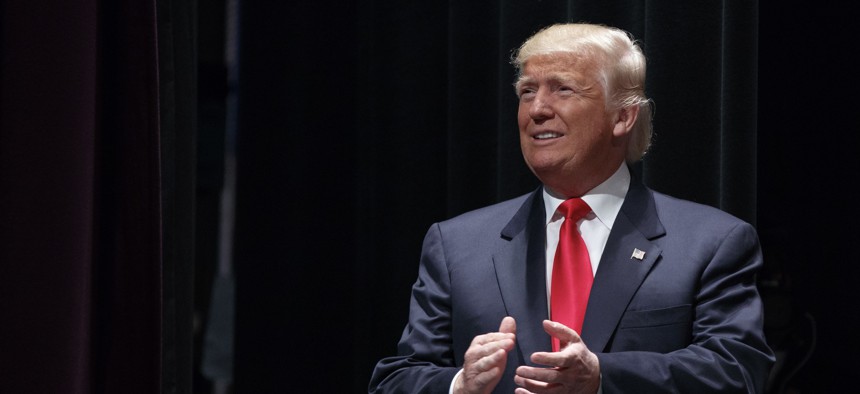
Republican presidential candidate Donald Trump arrives for a town hall on Sept. 6, 2016, in Virginia Beach, Va. AP / Evan Vucci
Trump's Defense-and-Budget Plan Has Been Tried Before
The GOP candidate's proposals for irresponsible tax cuts and uncapped defense spending look quite a bit like George W. Bush's.
Donald Trump is always on the warpath, but his latest expensive folly—a plan to dramatically expand the world’s most powerful military—will definitely hit one target: The U.S. economy.
In a speech and an interview yesterday, Trump offered several contradictory takes on how the U.S. should deal with its enemies. Of ISIS, he has said variously that he knows more about the militant Islamist group than U.S. military leadership; that he has a secret plan to defeat ISIS; that his secret plan is to ask military leadership how to defeat ISIS; and that he might need to fire those leaders when he gets into office.
“You know, it used to be to the victor belong the spoils,” he said last night of president Barack Obama’s decision to pull most U.S. troops from Iraq. “Now, there was no victor there, believe me. There was no victor. But I always said: Take the oil.”
It’s not clear what Trump will do with the U.S. military if he is elected (take the oil?). But we do know one thing: He’s going to spend money that the U.S. doesn’t have to do whatever it is he wants to do. In his speech, Trump outlined a massive expansion of the U.S. military, which already spends more money than its nearest seven competitors: $596 billion in fiscal year 2015, versus a combined total of $567 billion by China, Saudi Arabia, Russia, the UK, India, France and Japan.
Trump would build on that by expanding the Army by 90,000 soldiers by 2018, adding brigades to the Marine Corps, buying dozens more naval ships and hundreds more fighter aircraft, and developing a brand-new missile defense system. Among other things.
The biggest winner would be military contractors and defense boondoggles; the biggest loser will be future taxpayers. Why?
The defense budget is currently capped under a formula agreed to in a bipartisan deal to control U.S. spending, called the “sequester.” Even so, government bean counters have already forecast (pdf) that current U.S. policy will cost more than $120 billion over those caps by 2020 despite cost-cutting measures.
Trump’s plan includes lifting the spending caps at an estimated cost of $450 billion over ten years, but the specifics of his plan seem to call for even more spending than that. Still, using the conservative cost assumption of $450 billion, the Committee for a Responsible Federal Budget estimated yesterday that Trump’s plans may result in borrowing $150 billion over 10 years.
But even that is an underestimate, because Trump’s plans to pay for his goodies range from wishful thinking to politically impractical. They include: having allies pay more to the U.S.; wading into battles between congressional committees to cut pork barrel spending; increasing IRS funding to collect unpaid taxes; stopping waste; and cutting domestic spending below today’s rock-bottom levels. All those measures won’t begin to cover the other $300 billion Trump hopes they will.
Combined with more than a trillion dollars in promised tax cuts during the first four years of his term, Trump is essentially promising to blow up U.S. debt. Adding just $1.2 trillion to borrowing during one term in office would boost U.S. debt-to-GDP to 84%—the highest since World War II, though without the existential threat.
Of course, many economists think that a government plan to borrow money cheaply and invest it in the economy could make sense, particularly in research, education and infrastructure. But defense spending, while it may create jobs, is seen as offering little stimulus compared to other spending.
All told, Trump’s plan for irresponsible tax cuts and uncapped defense spending looks quite a bit like one mainstream Republican: George W. Bush.
Too bad that experiment didn’t end well.





